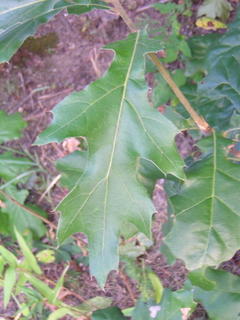Yellow
 This black oak (Quercus valutina) sapling is older than it looks. It grows slowly and carefully in the understory of Norway maples, white oaks, and its parent tree, a 30 foot tall black oak. It gets late day sun and its thick green leaves make the most of it, but do not make too much of it. It waits. One leaf or two, patiently riding out the seasons. It has no need to rush, it has confidence in its place. Perhaps, one day, the canopy behind it will open to the east and it will shoot skyward. Or maybe its life will be lived down here at the edge of a right-of-way. Either way, it seems, is fine with this oak. It is known as a black oak, but it is also called a yellow oak. Called the yellow because it produces a yellow substance under its bark that used to be dried and powdered and was used to die clothing yellow. We no longer have such relationships with this tree and most people no longer realize the existence of a yellow skin hidden beneath this nondescript specimen. The bulk do not even see this tree, who pass it every day, pick at it mindlessly with their fingers as they walk chattering on a cellular phone about things happening elsewhere, and jump into their cars.
This black oak (Quercus valutina) sapling is older than it looks. It grows slowly and carefully in the understory of Norway maples, white oaks, and its parent tree, a 30 foot tall black oak. It gets late day sun and its thick green leaves make the most of it, but do not make too much of it. It waits. One leaf or two, patiently riding out the seasons. It has no need to rush, it has confidence in its place. Perhaps, one day, the canopy behind it will open to the east and it will shoot skyward. Or maybe its life will be lived down here at the edge of a right-of-way. Either way, it seems, is fine with this oak. It is known as a black oak, but it is also called a yellow oak. Called the yellow because it produces a yellow substance under its bark that used to be dried and powdered and was used to die clothing yellow. We no longer have such relationships with this tree and most people no longer realize the existence of a yellow skin hidden beneath this nondescript specimen. The bulk do not even see this tree, who pass it every day, pick at it mindlessly with their fingers as they walk chattering on a cellular phone about things happening elsewhere, and jump into their cars.Are we changed by the visible oppression in New Orleans? Does seeing classism and the despising of the poor jar something in our collective conscience about loving others as ourselves and the like? Does the deep visceral gut-wrenching horror that we feel when we learn that the police and National Gaurd treated the victims like criminals themselves, after they finally arrived on the harrowing scene, leave us reminded of our obligations and stir up that better part of our nature, dormant for so long? Can tragedy make us better people, somehow? The next weeks and months and the way we carefully assess the spin will tell. Just remember, New Orleans was not caused by patience like the understory oak, it came from petulance of the socially sanctioned kind.

0 Comments:
Post a Comment
<< Home